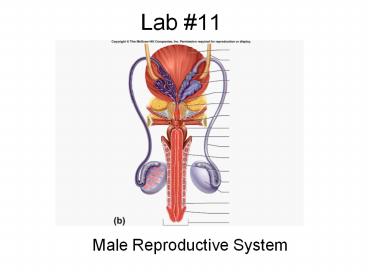Lab #11 Male Reproductive System Male Reproductive System - PowerPoint PPT Presentation
1 / 18
Title:
Lab #11 Male Reproductive System Male Reproductive System
Description:
Lab #11 Male Reproductive System Male Reproductive System Produces male gametes (spermatozoa) Transports the gametes to the female reproductive tract Secretes the ... – PowerPoint PPT presentation
Number of Views:2117
Avg rating:3.0/5.0
Title: Lab #11 Male Reproductive System Male Reproductive System
1
Lab 11
- Male Reproductive System
2
Male Reproductive System
- Produces male gametes (spermatozoa)
- Transports the gametes to the female reproductive
tract - Secretes the male reproductive hormone
testosterone
3
Testes
Each testis is wrapped in a connective tissue
sheath called the tunica albuginea They are
surrounded by the scrotum and descend outside the
body The scrotal sac is lined with a layer of
smooth muscle called dartos muscle When the body
is cold the dartos muscle contracts bringing the
testes closer to the body
4
The testes contain numerous seminiferous tubules
where spermatozoa are produced The outermost row
of spermatogonia reproduce mitotically to
produce. . . Primary spermatocytes which then
undergo meiosis to become secondary spermatocytes
which then become . . . Spermatids as they move
closer to the lumen and eventually lose their
remaining cytoplasm and mature into
spermatozoa Sustentacular (Sertoli) cells assist
in the movement of the primary spermatocytes In
between the tubules are triangular regions of
interstitial cells where testosterone is produced
5
(No Transcript)
6
Tail
7
Sperm
8
(No Transcript)
9
(No Transcript)
10
Sperm Maturation
- Sperm maturation ( or capacitation) occurs in the
epididymis (takes 60 days) - If spermatozoa are removed from the interior of
the testis they are not capable of fertilizing a
female egg
11
Spermatic Cord
- A complex cable consisting of
- Ductus deferens
- Testicular artery and veins
- Nerves
- Cremaster muscle
- Ends at the inguinal canal
12
Ampulla
Ejaculatory duct
Seminal Vesicle
Prostate Gland
Bladder
Bulbourethral gland
Urethra
Penis
Rectum
Ductus Deferens
Glans
Prepuce
Epididymis
Testis
Scrotum
13
Formation of Semen
- Spermatozoa leave the ampulla and enter the
ejaculatory duct where the seminal vesicle merges
and adds seminal fluid (adds 60 to final volume) - The prostate gland adds a buffering fluid (40 of
final volume) - Bulbourethral (Cowpers) glands add a lubricant
as the seminal fluid passes through the
membranous urethra
14
Pathway of Sperm
- Seminiferous tubules
- Rete testes
- Epididymis
- Ductus (vas) deferens
- Ampulla
- Ejaculatory duct
- Prostatic, membranous, spongy urethra
15
(No Transcript)
16
Dorsal arteries and veins bring blood to and away
from the penis
Bulb
Root
Crus
Corpus cavernosum
Erectile tissue
Corpus spongiosum
Glans
17
(No Transcript)
18
Perineum
- The perineum is defined by
- Pubic symphysis at the anterior point
- Ischial tuberosities at the lateral points
- Coccyx at the posterior point
- Forms a posterior anal triangle and an anterior
urogenital triangle

